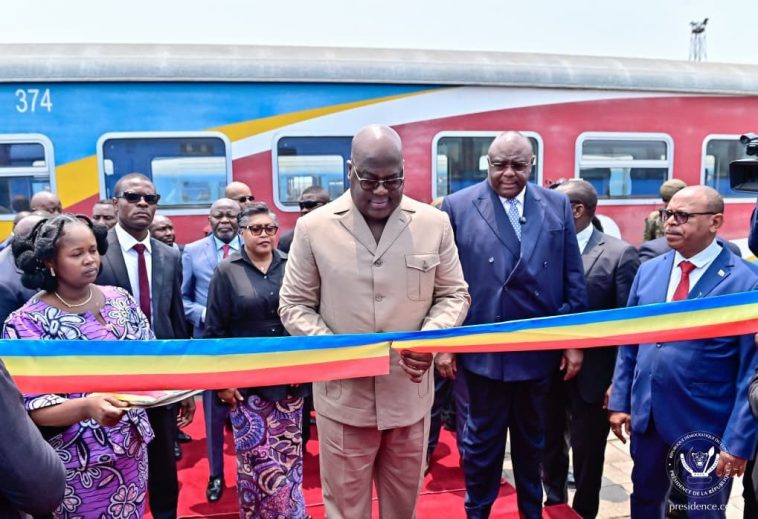The whistle of a train echoed again through Kinshasa’s Central Station on September 5 as President Félix Tshisekedi inaugurated the long-awaited return of passenger service on the Kinshasa-Matadi rail line, a 365-kilometer corridor linking the capital to the country’s main seaport.
The line, abandoned for nearly five years and long seen as a strategic artery for both goods and people, has been fully rehabilitated by the state-owned Office National des Transports (Onatra) with financing from a logistics tax. At the ceremony, Mr. Tshisekedi also received seven new passenger cars, acquired in partnership with a Chinese company.
“Acceptable comfort for passengers”
“This train remains the best alternative to other means of mass transport in a megacity of nearly 20 million inhabitants,” said Martin Lukusa, Onatra’s director general.
Julie Mbuyi Shiku, the minister of state portfolio, called the relaunch “a structuring project with real effects,” describing it as both a technical achievement and a symbol. “We celebrate the return of confidence and hope,” she said, noting that Onatra, once a flagship of multimodal transport, is reclaiming its central role.
Jean-Pierre Bemba, the deputy prime minister in charge of transport and territorial connectivity, announced the imminent arrival of five new locomotives and 40 container wagons, alongside the revival of urban rail service linking Central Station to N’djili International Airport and the Kitambo district.
Invited to cut the ribbon, Mr. Tshisekedi inspected the new wagons himself, remarking on what the presidency described as “acceptable comfort for passengers.”
Easing Pressure on a Strategic Corridor
Jean-Pierre Bemba also outlined plans to revive urban rail links in Kinshasa, starting with a Central Station–N’djili Airport shuttle that will cut travel to under 30 minutes. The Central Station–Kitambo Magasin line is slated for reopening, while the Kinshasa–Kasangulu service already runs twice daily.
The Kinshasa–Matadi relaunch includes seven new passenger cars acquired last year, bolstering a fleet of locomotives, freight wagons and container carriers.
The relaunch is expected to ease the evacuation of the four million tons of goods that pass each year through the port of Matadi, unclog the strategic corridor between Kinshasa and Kongo Central, and reduce pressure on National Road No. 1. It should also improve mobility and strengthen both domestic and international trade.
The government has even larger ambitions. A feasibility study is underway for a 150-kilometer extension connecting the deep-water port of Banana to the Matadi-Kinshasa line via Boma. The project would create a continuous rail corridor — Banana-Boma-Matadi-Kinshasa — opening new prospects for moving goods to and from the country’s main ports.
M&B with Adiac-Congo, Agence Ecofin and Congolese Presidency





